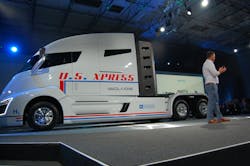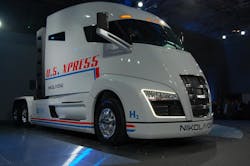So Nikola Motors Co. unveiled its Nikola One prototype Class 8 highway sleeper tractor last week at its “world headquarters” in Salt Lake City, Utah – a truck that runs on electricity generated by a hydrogen-powered fuel cell.
The company claims the Nikola One’s range is between 800 to 1,200 miles on a single fill up and, with its fuel cell linked to a 320 kilowatt-hour lithium-ion battery pack, the truck can crank out 2,000 hp and 2,000 ft.-lbs. or torque – enough to handle heavy-haul operations, which is a trucking niche Trevor Milton, Nikola’s president and CEO, is including in his marketing plans.
The sales pitch for the Nikola One is pretty straightforward; indeed, refreshingly so, if the company and its partners (Ryder System being playing perhaps the most critical role handling sales, service, and warranty coverage for the vehicle) can make good on their claims.
Milton said during the event that he expects to “sell” the Nikola One tractor via an “all-inclusive and integrated lease” costing anywhere from $5,000 to $7,000 per month.
And by “all-inclusive” Milton means “all-inclusive”: Not only does it cover the vehicle, but all of its hydrogen fuel as well (“one million miles worth,” he explained), along with maintenance support, warranty coverage, tires, wiper blades, everything – even truck washes.
Milton plans to provide hydrogen fuel and amenities to Nikola One owners through a yet-to-built network of 364 refueling “sites” modeled on the Maverik convenience store chain – making refueling a “destination” for Nikola One operators, rather than a necessary evil.
Another twist Milton is planning for the Nikola One: Incorporating a freight matching service, Nikola Shipments, as part of the trucks base package of services.
Truck drivers will be able to access that service via the 21-in. computer screen built into the dashboard – a computer screen that technicians can also use as a diagnostic tool as well.
“Look at it this way: an iPhone would not be an iPhone of you couldn’t listen to your music, send text messages, take photographs, surf the web, and do hundreds other things with it,” Milton explained. “That’s what we are trying to do with the Nikola One. It won’t happen all at once, but essentially we’re going to try and integrate everything a driver needs into this one vehicle.”
Of course, there are safety and environmental angles to the Nikola One being played as well.
The air disc brakes on the Nikola One will be connected to a “regenerative braking” system to provide more stopping power – stopping power further enhanced through linkage with automatic emergency braking systems (AEB) such as Bendix’s Wingman Fusion and Meritor’s OnGuard Active product.The Nikola One’s battery pack, electric motors and fuel cells will all be positioned at or below its frame rails – providing more stability and a lower center of gravity to reduce the chances of a rollover.
Then there are the environmental factors. For starters, fuel cells only emit water vapor, so no expensive and heavy exhaust aftertreatment systems will be needed. Milton also expects the Nikola One to last at least two million miles due to its independent suspension and electrical powertrain, with the first million miles in operation for “new owners” and the second million for those who favor buying used trucks.
Even the lithium-ion battery pack can be re-sold, Milton noted: “sliced up” for use in electric back up generating systems for residential homes. “The goal here is to reuse and recycle as much as possible from the truck,” he said.
Yet will trucking companies pay $5,000 to $7,000 a month for a hydrogen-powered torpedo-looking truck? And will truck drivers be willing to pilot such rigs?Sandeep Kar, global vice president for mobility at Frost & Sullivan, for one, believes total cost of ownership or “TCO” factors may play into the Nikola One’s favor.
“The North American trucking industry is grappling to find ways to address the TCO issue [with] fuel, lease, and repair and maintenance costs are the key components to be tackled,” he explained in a recent report. “They contribute to over half of a truck’s TCO.”
With Nikola claiming that its Nikola One prototype can offer twice the power and two to four times more fuel efficiency than an average Class 8 diesel truck, plus all the fuel and maintenance costs rolled into the lease price for good measure, Frost & Sullivan estimates that will provide savings of $21,127 per year on a lease purchase deal versus a traditional Class 8 diesel truck.
And even though the Nikola One won’t start full production until 2020, the company said that it’s received over 8,000 reservations for the vehicle with deposits of $1,500 each. Milton claimed during the unveiling that amounts to nearly $4 billion worth of pre-orders – money that Nikola will no doubt use to help fund the development of its hydrogen refueling network.
Will that be enough to sway truckers to start switching to hydrogen- powered electric big rigs? We’re going to find out as clock tracking the time to full production of the Nikola One is now ticking.



